 United States of America (1944)
United States of America (1944)
Light Tank – 4,731 Built
Introduction
The M24 Chaffee, the replacement for the M3/M5 Stuarts, was a leap forward in light tank design, improving the concept in all directions. It had modern torsion bar suspensions, completely revised welded steel armor, improved protection and, more importantly, a much more potent lightweight 75 mm (2.95 in) main gun. Although late in the game (just in time for the Battle of the Bulge, winter 1944), the Chaffee was so successful, being efficient, simple, reliable and rugged, that that it was largely exported after the war and stayed in service with many armies until the 1980s and beyond, encompassing most of the Cold War.
What came before the M24 Chaffee?
The M3 and M5 Stuart series of US built light tanks were neither properly armed or armored for survival on the post-1941 battlefield. There was a need for an up-gunned fast light tank with increased protection to meet the needs of an armored reconnaissance unit.
These tanks needed to go ahead of the main armored thrust to scout out the location of enemy units, report their location, call down an artillery barrage or air attack and leave without engaging heavily armed enemy tanks if at all possible. They were not meant to take part in tank on tank combat. They had to rely on their speed and maneuverability to get them out of trouble.
The idea of having a more powerful light tank to replace the M2A4 and M3 designs had been considered as early as autumn 1940. A few months later, in January 1941, this need was translated into a definite requirement which stated that the tank should be a 14-tonner, with a low silhouette, armor of 38 mm (1.5 in) maximum thickness and mounting a 37 mm (1.46 in) gun.
Two pilot models were designed at the Rock Island Arsenal. The first, designated the T7, was to have a welded hull, a cast turret and modified vertical volute suspension. The second pilot, the T7El, would be of riveted construction, with a cast/ welded turret and horizontal volute suspension.

M24 Chaffee of D company, 27th Tank Battalion, 20th Armored Division driving down the streets of Munich on 30th April 1945.
In fact the T7El was never completed because riveted armor went out of favor, but the chassis was still used for transmission and suspension trials, powered by the Continental engine.
Following on from the building of a wooden mock-up of the T7, Rock Island Arsenal were asked to construct three more prototypes, designated the T7E2, T7E3 and T7E4, to test different armor, engine and transmission configurations. Of these, the T7E2 showed the most potential — it had a cast hull, top and turret and a Wright R-975 engine. The design was approved in December 1941, but while the pilot model was being built it was decided to up-gun it to 57 mm (2.24 in).
This gun, an adaptation of the British 6-pdr, was to be fitted to the Canadian-built Ram tank, so a Ram turret ring was incorporated and the tank completed in June 1942. The Armored Forces later asked if it could be modified to take a 75 mm (2.95 in) gun and this was also agreed, although it meant that the turret had to be redesigned. The other major change during development was an increase in the armor thickness to 63 mm (2.52 in) which put up the tank weight to 25 tons, thus effectively taking it out of the light tank class!
It was therefore reclassified as the Medium Tank M7 in August 1942 and standardized. An order for 3000 vehicles was placed with the International Harvester Co., production to begin in December 1942. Meanwhile, the pilot model had been further tested at the Armored Force HQ at Fort Knox, who found that it was grossly underpowered. Its combat weight with crew and full battle stowage was now 29 tons, so work on a re-engined model, the M7E1 begun.
While this saga was taking place, the Sherman M4 medium tank had gone into full production as the standard medium and the Ordnance Board rightly queried with the Armored Forces if they needed the M7 as well. The Armored Forces saw the wisdom of this and production was halted after only a handful of M7s had been produced.
The work on the M7E1 was also stopped and the T7/M7 series declared obsolete. The M7 was thus never used by the US Army.
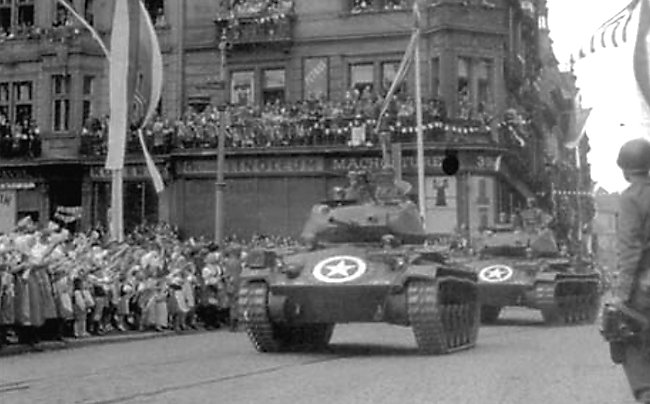
M24 light tanks of the 38th Cavalry Reconnaissance Squadron, 102nd Cavalry Group taking part in the victory parade in Prague, Czechoslovakia, July 1945. The Allied stars on the front were only painted on after the war for the parade.
Production and Development
Despite this fiasco, the need for a better-armored light tank with a more powerful gun was still apparent, so the Ordnance Department began work in conjunction with Cadillac, the makers of the M5 series, to design a completely new light tank which would incorporate the best features of all the previous designs, including everything that had been learnt from the T7/M7 program. Cadillac went ahead with a pilot model, designated the T24.
This used twin Cadillac liquid-cooled engines and hydramatic suspension of the M5. It mounted a lightweight M5 75 mm (2.95 in) gun which had been developed for use in the B-25 Mitchell Bomber.
It had a concentric recoil which thus saved space in the turret and was not as heavy as the normal M3 75 mm (2.95 in) gun. A weight limit of 18 tons was set as the ideal target for this tank, which meant that the maximum thickness of armor would only be 25 mm (0.98 in).
The first pilot model, the T24, was completed in October 1943 and was so successful that Ordnance immediately authorized a production order for 1000 AFVs, which they later raised to 5000. Production started in March 1944 at the Cadillac and Massey-Harris plants, M5 production ceasing at these plants simultaneously. In all, they produced 4731 M24s, including variants. The first deliveries were made to the US Army in late 1944 and the first M24s, or Chaffees as they were called after the great General Adna Chaffee, ‘Father of the Armored Force’, saw action in winter 1944 in Europe. Interestingly, it was the British, with their love of nicknames, who first called the M24 the Chaffee, the name then being adopted by the US Army.
The M24 Chaffee
The Light Tank M24 carried a crew of four; commander, gunner, driver and assistant driver, the latter moving up into the turret and serving as loader when the tank was in action.
It was, of course, also possible to have a permanent five-man crew when manpower allowed. The layout was normal, with a driving compartment in the front, fighting compartment in the center and engine compartment in the rear. Dual controls were provided, one for the driver and one for the assistant driver to be used in an emergency.
The tank was driven by two eight-cylinder, 90 degrees V-type liquid-cooled Cadillac engines, through two hydramatic transmissions, a transfer unit with mechanically selected speed ranges — two forward and one reverse controlled differential for steering and braking which was located in the front of the hull, two final drives, and connecting propeller shafts.
Wide steel block tracks, 16 inches wide, provided the means of traction. Torsion arm suspension was used for the dual track wheels, and included a compensating wheel at the rear of each side to keep track tension constant regardless of obstacles.
The hull was a completely welded structure, except for portions of the front, top and floor, which were removable for servicing. The hull was divided into two compartments: the fighting and driving compartment at the front and the engine compartment at the rear. These compartments were separated by a bulkhead extending from side to side and from the roof down to the bulkhead extensions, which in turn extended forward far enough to cover the transfer unit. The front of the hull sloped downwards at the top and upwards at the bottom to form a ‘<‘.
To keep the weight of the tank down the armor was not very thick. The front glacis was 1 inch (25 mm) thick. The top of the hull was only 2/5 inch (10 mm) thick. The sides of the hull sloped inwards at the bottom. The thickness of the armor on the hull side of the M24 Chaffee was not uniform: the front 2/3 of the armour was 1 inch (25 mm) thick but the last 1/3 length of the side armor that covered the engine compartment was only 3/4 inch (19 mm) thick. The rear hull armor was 3/4 inch (19 mm) thick. The turret armour was 1 inch (25 mm) thick with the addition of a 1 1/2 inch (38 mm) thick gun mantel.
The fighting compartment comprised a turret of approximately 60 inches inside diameter, mounted on a continuous ball bearing mounting, with 360 degrees traverse by means of either a handwheel or a hydraulic mechanism. The 75 mm (2.95 in) gun and the coaxial .30 cal (7.62 mm) Browning machinegun were mounted in the turret, with elevation from -10 to +15 degrees.
A second .30 cal (7.62 mm) was mounted in the hull on the assistant driver’s side and a .50 cal (12.7 mm) anti-aircraft machine-gun was pintle mounted on top of the turret. The tank could be fitted with a dozer blade as necessary.
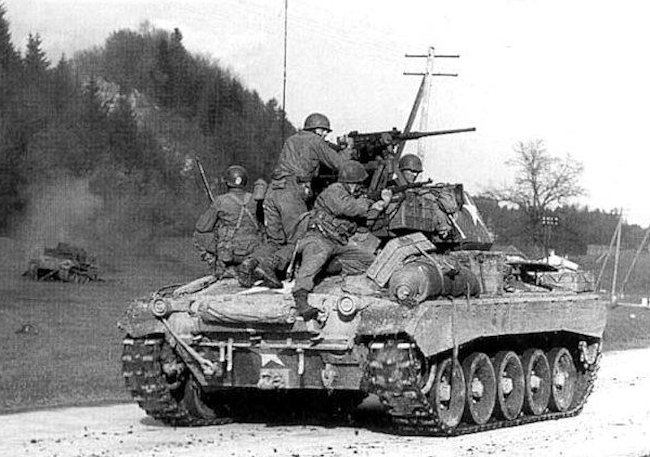
M24 Chaffee Light Tank of the 20th Armored Division, 7th Army, near Salzburg in Austria, 4th May 1945 just a few days before the end of the war.
US M24 Chaffee Tanks
The M24 entered service with the US Army in winter 1944, during the Battle of the Bulge. One of the first units to get them was 740th Tank Battalion, which took over two M24s quite by chance during the ensuing ‘flap’. More vehicles were deployed to the battle as they became available. They continued to replace older Stuart light tanks until the end of the war.
The 23rd Cavalry Reconnaissance Squadron, 16th Armored Division were issued with M24 Chaffee light tanks and used them as part of their advance towards Pizen in Czechoslovakia at the end of the war, in May 1945. They added black paint over the olive green base color of the factory issued tanks to improve the vehicle’s camouflage.
Patton’s Third Army allocated M24 Chaffees to F troop, 2nd Cavalry Reconnaissance Squadron for their advance towards Bavaria, Southern Germany, in April 1945. A blue disk with a white trim and the letter A was painted on their turrets.
M24 tanks did not see operational service in the Philippines before the end of WW2. None arrived in Okinawa, Japan until after the fighting had ended but they were displayed alongside M26 Pershing tanks for troop ID training in August 1945.
F troop, 81st Reconnaissance Squadron, 1st Armored Division used M24 Chaffee light tanks in Salvara in Italy, April 1945.
M24 Chaffee tanks in Japan
After VJ day, Victory in Japan day, at the end of World War II, American forces landed on mainland Japan. The M24 Chaffee light tank was chosen for occupation duty in Japan, rather than the heavier and larger Sherman and Pershing tanks. Japanese roads and bridges were not designed to accommodate vehicles of such weight and size.
The four US Army divisions with the Eighth Army in Japan (7th, 24th, 25th Infantry and 1st Cavalry) each had an attached tank battalion: the 77th, 78th, 79th and 71st Tank Battalions respectively. In reality, each battalion had only a single company of M24 light tanks in Japan.
British M24 Chaffees
There were a few Chaffees in British service, supplied by the United States in 1945 and they remained in service for a short while after the war ended. The M24 Chaffee light tank was not extensively exported under the Lend Lease program because production only started in 1944. The only significant recipient of this tank was the British Army. They had ordered 842 vehicles but received between 203 to 302 in 1944 and a further 99 in 1945.
They were deployed in small numbers in April 1945 replacing the American built Stuart light tanks in the last few weeks of World War Two. Units known to have them include the reconnaissance squadrons of the 7th Armoured Division (The Desert Rats).
At least two of these tanks were lost in combat prior to the war finishing. By June 1945, the 7th Armoured Division had an operational strength of 28 M24 Chaffee light tanks. By the summer of 1945, small numbers of M24 tanks were sent to Italy and India for training. The Soviet Union was also supplied with two tanks for evaluation in 1945. Most British M24s were given to the Dutch Army. There are a few survivors in the Barracks Museum in Amersfoort, The Netherlands.
The Muckleburgh Military Collection in Norfolk, England has a restored working British M24 Chaffee, B Squadron, 1st Royal Tank Regiment, 22nd Armoured Brigade which was part of the 7th Armoured Division (the Desert Rats). The number ’52’ painted on the front of the tank indicates the intermediate regiment in the Brigade, which by 1945 when they received a few M24s, was the 1st Royal Tank Regiment. The Red Stags head on a white background above the number 52 is the badge of 22nd Armoured Brigade.
It is highly probable that the Museum has made a slight mistake. Strictly speaking, the B squadron Red Square marking should be yellow. Red was for the senior regiment, the 5th Royal Inniskilling Dragoon Guards, who would have had the tactical number 51. The junior regiment, the 5th Royal Tank Regiment, would have had the tactical number 53 and its squadron markings would be painted in blue. The large number 5 in the square indicates that the tank belonged to the 5th troop.
Canadian M24 Chaffee Tanks
With the US-Canadian post-war agreement to buy surplus M4A2 76mm (W) HVSS Shermans, the deal added 90 M5A1 Stuart light tanks and 32 M24 Chaffee light tanks as well. These were all from US war stocks. In May 1945, the Canadian 4th Armoured Division received its first M24 Chaffee the trials. The Canadian Army’s verdict was that it was “impossible to speak too highly of its design and performance.”
The main part of the M24 Chaffee order started to arrive around December 1949. Royal Canadian Armoured Corps (RCAC) records show five M24 tanks arrived in the first batch on that date, the rest started to arrive at the Long Point depot in Montreal. In October 1952, there were two held in ordnance stocks, 17 at the RCAC School, one at the RCEME School and one assigned to Lord Strathcona’s Horse for a total of 21. For January 1954, there were 18 at ordnance depots, one at the RCAC School and two assigned to Active Force units. The M24 was declared obsolete by the Canadian Army in April 1958.
We would like to thank Anthony Sewards for this information.
Australian Army M24 tank trials
During the Australian Army tank trials of the M24 in Bougainville, in the Pacific, in November 1945, it was found that a trench of 7-foot wide could be negotiated by the Chaffee but that it was stopped by an 8-foot wide trench.
The Australian War Office concluded that ‘these tanks under trial proved that, although their mechanical ability was outstanding and their armament ideal for such a role, their light armor and inability to maintain constant slow speed consistent with infantry pace rendered them unsuitable for service under tropical conditions.’
It is not very often that a tank gets criticized for being too fast. The M24 was a recce tank and a hydramatic transmission could not work at low speed as the transmission would always be hunting for a gear.
The Korean War
The M24 really proved itself during the opening phases of the Korean war in 1950, when they were the only armor available to the hard-pressed US and South Korean forces. The Chaffee was finally replaced in the US Army by the M41.

French Army M24 Chaffee Light Tank at the French Tank Museum in Saumur, France. It was delivered to the French Army after the WW2 1945 victory. It took part in the French Indochina (Vietnam) campaign and also in Algeria.
French M24 Chaffees
The French Army M24 Chaffee Light Tanks were delivered after the WW2 1945 victory. They took part in the French Indochina (Vietnam) campaign and also in Algeria. With the exception of small arms, a great deal of the equipment used by the French in Indochina was American. Several Chaffee tanks, such as this one, were parachuted into Dien Bien Phu in pieces and then assembled. The French soldiers nicknamed them ‘Bisons’.
They employed ten M24s in the Battle of Dien Bien Phu. In December 1953, ten disassembled Chaffees were transported by air, in British front opening Bristol Freighters leased to the French Government, to provide fire support to the garrison. The French unit that used the M24 at Dien Bien Phu was the 3rd Company of the 1st Light cavalry Regiment (3/1 RCC). They had one command tank (named Conti) and 3 divisions with 3 tanks per division. Morale was considerably raised by the arrival of the M24s by air and, once assembled, they made a huge difference to the defence of DBP.
The French tank divisions were denoted by colours and each tank was given a name. Bleu Division : Bazeille, Douaumont, Mulhouse. Rouge Division : Ettlingen, Posen, Smolensk. Vert Division : Auerstaedt, Ratisbonne, Neumach. Bleu and Rouge divisions were stationed at the central area. Vert was stationed at the south area – Isabelle. French troopers assembled the M24s at Muong Thanh Airport in 1954. Most of them were destroyed by Viet Minh artillery or captured by Viet Minh troops. One captured M24 was used to carry the image of President Ho Chi Minh on North Vietnam Victory Day 7/5/1954.
Later, the ones used by the ARVN (South Vietnam) became notorious as “Voting Machines” as Commander of the Air Force Marshal Ky used them to prevent the overthrow by Army elements of the “constitutional” Government after 1965. ARVN M24 Chaffee light tanks had figured strategically in the overthrow of the Diem Minh Khanh and Su’u regimes.
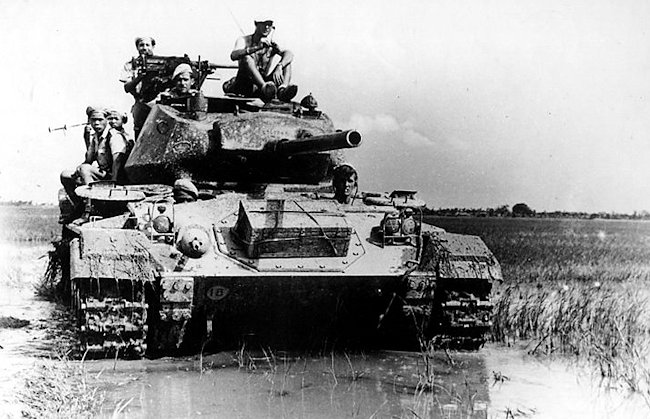
French Army 3rd Company of the 1st Light cavalry Regiment (3/1 RCC) M24 Chaffee Light Tanks in Dien Bien Phu, Vietnam.
Belgium M24 Chaffees
The Belgium Army had 51 M24 Chaffee Light Tanks and they were issued to their cavalry regiment 1st Regiment Chasseurs à Cheval (1ChCH) Div Recce Regt to be used for reconnaissance work against any potential Soviet invasion.
Dutch M24 Chaffee Tanks
A total of 50 vehicles were delivered to the Dutch Army. They served with the 102nd and 103rd Reconnaissance Battalions at the Prins Bernhard barracks in Amersfoort from 1952 till 1961. A Dutch tank squadron comprised of 22 Sherman tanks. A Self-propelled Artillery Squadron would be issued with six 105mm Sherman tanks. An Infantry Squadron would be made up of three platoons. Each platoon had four jeeps, two M24 Chaffee light tanks and two M21 81mm Mortar halftracks. The remainder of the armored fighting vehicles not in use with the operational Dutch Army Battalions were at the Willem III barracks in Amersfoort (school). The museum at the barracks currently has two surviving Chaffee tanks: one has been restored to a working condition.
Greek M24 Chaffee Tanks
The US Government sent 206 M24 Chaffee light tanks to Greece between 1950-51. They formed the 392nd and 393rd Tank Regiments in Macedonia as well as Independent Armored Companies, notably the 2nd, 6th, and 10th Companies integrated respectively with the II, VI and X Infantry Divisions. After 1962, they were gradually transferred to the Aegean islands and by 1975 this transfer was complete. They formed part of the Independent Recon Companies that were integrated into Tank Battalions. They served until 1992. Some were turned into coastal defense bunkers.
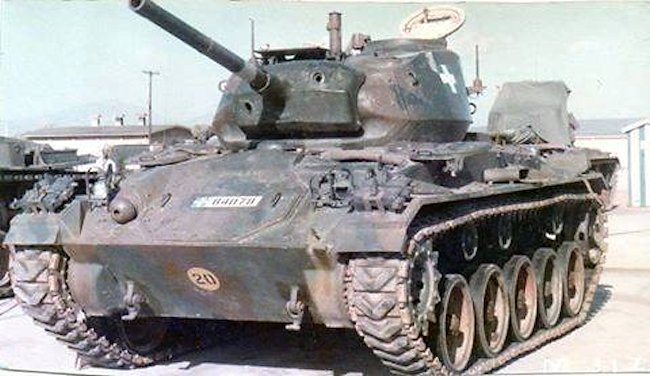
Greek Army M24 Chaffee Light Tank
Variants
At the same time as the M24 was being developed, there was a stated requirement for a family of AFVs, known as the ‘Light Combat Team’. This would comprise a series of gun tanks, self-propelled guns, and special purpose tanks, all of which would use the same basic chassis. The advantages of standardization of components for manufacture, and, just as importantly, the simplification of maintenance, spares holdings and repairs, from such a system can be well imagined. This led to a number of variants being made like the M24 Chaffee Dozer.
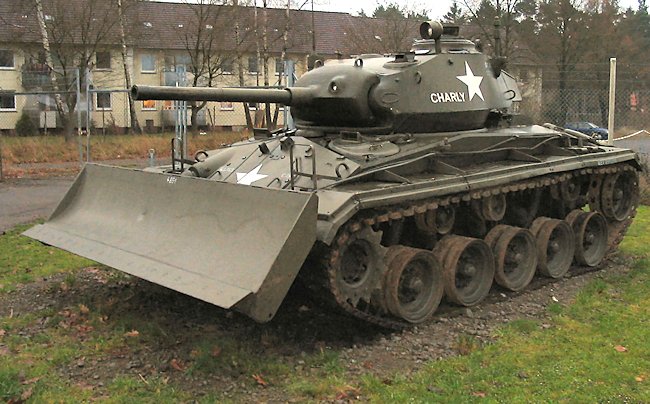
M24 Chaffee Light Tank fitted with a dozer blade.
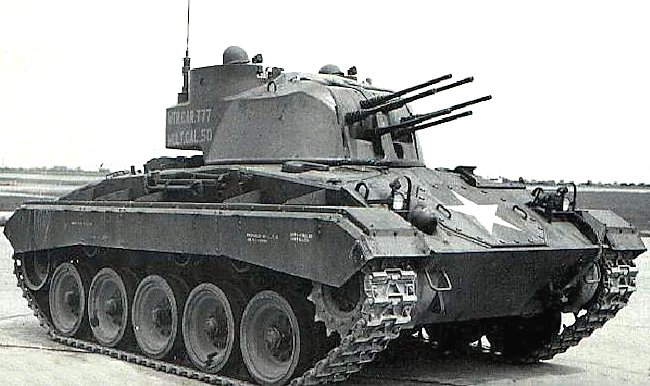
T77E1 Multiple Gun Motor Carriage AA GMC on an M24 Chaffee chassis
There were a few unsuccessful variant prototypes. These included the T38 Mortar Motor Carriage and the T77E1 Multiple Gun Motor Carriage. There was also a swimming device designated the M20, which allowed the standard M24 to swim ashore from a landing craft, and comprised fore and aft pontoons, plus grousers added to the tracks to give better propulsion through the water. The following two variants were more widely used.
M19 MGMC
Some 285 of these had been completed at the end of the war, but this AA tank, which mounted twin 40 mm (1.57 in) guns in an AA mount, became standard US Army equipment for many years after the war. It had a crew of six, weighed 38,500 lbs and carried 336 40 mm rounds.
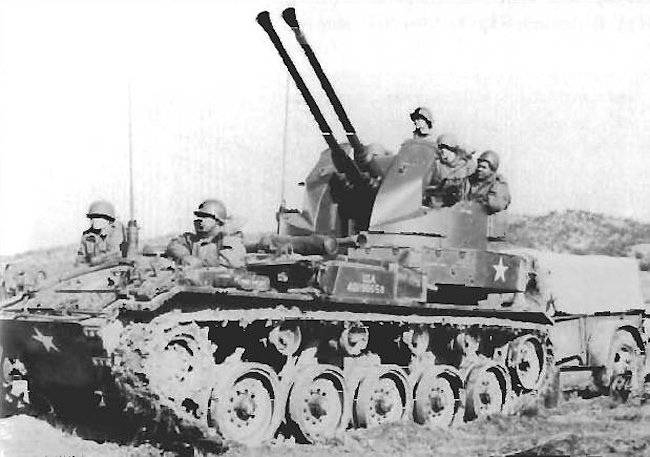
The M19 Gun Motor Carriage armed with 40mm guns in an anti-aircraft mount
M41 HMC
Known unofficially as the ‘Gorilla’, it mounted a 155 mm (6.1 in) M1 howitzer and, although only sixty were completed before the end of war, it became a standard US Army post-war equipment, like the M19 MGMC. It had a crew of twelve, eight of whom had to be carried in an accompanying ammunition carrier. It weighed 42,500 lbs and 22 rounds of 155 mm ammunition were carried in the vehicle.
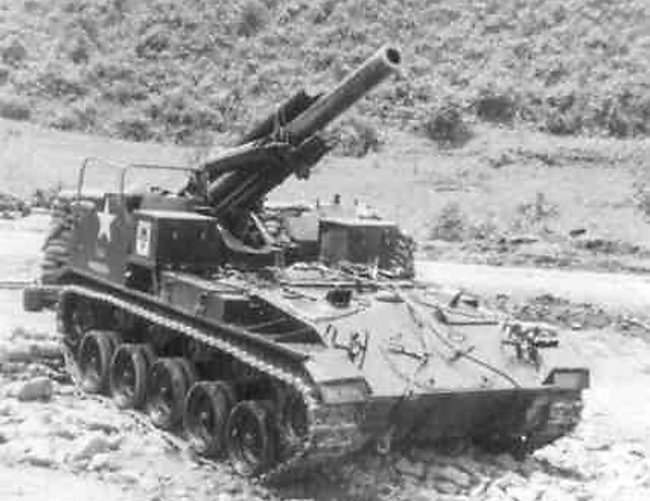
Battery A, 92nd Armored Field Artillery Battalion, 8th Army near Kumhwa, Korea 8th June 1952
Specifications |
|
| Dimensions (L-W-H) | 18’2″ x 9’8″ x 9’1″ 5.54 x 2.98 x 2.77 m |
| Total weight, battle ready | 20.2 tons (18.32 tonnes) |
| Crew | 5 (driver, commander, gunner, loader, co-driver/radio operator) |
| Propulsion | Twin Cadillac 44T24 8-cylinder 4 cycle petrol/gasoline 148 hp engine |
| Max Road Speed | 35 mph (56 km/h) |
| Off Road Speed | 25 mph (40 km/h) |
| Range | 100 miles (160 km) |
| Armament | 75 mm M6 gun in mount M64 in turret, 48 rounds 2x Cal.30-06 (7.62 mm) Browning M1919A4 machine guns .50 cal (12.7 mm) Browning M2HB machine gun |
| Front Armor | 25 mm (1 in) |
| Front Side 2/3 Armor | 25 mm (1 in) |
| Rear side 1/3 Armor | 19 mm (3/4 in) |
| Rear Armor | 19 mm (3/4 in) |
| Turret Armor | 25 mm (1 in) |
| Gun Mantel Armor | 38 mm (1 1/2 in) |
| Production | 4,731 built |

M24 of the US 18th Cavalry Reconnaissance Squadron, 740th Tank Battalion, Battle of the Bulge, winter 1944-45
Chaffee of the US Army 1st Armored Division in Bologna, Italy, late April 1945

US Army M24 Light Tank in Germany, 1945

M24 Chaffee fitted with the long armed Dozer Blade

M24 of the US Army in the Netherlands, winter 1944-45

Chaffee of the 752nd Tank battalion, February 1946

M24 of F Troop, 2nd Cavary Reconnaissance Squadron, Bavaria, Germany, 1945

Chaffee from the 23rd Cavalry Reconnaissance Squadron Pizen, Czech Republic, 1945

British M24 Chaffee, Light Tank C Squadron, Reconnaissance Regiment, 5th Infantry Division, Germany 1946

Chaffee of the British 1st Royal Tank Regiment, HQ Squadron, 22nd Armoured Brigade, 7th Armoured Division, Germany 1945
Variants

M19 MGMC

M41 HMC 155 mm M1 howitzer ‘Gorrilla’

M37 HMC 105 mm GMC
Cold War

Chaffee in the Korean War, 1951.

French M24, 1st Regiment of Chasseurs à Cheval, Dien Bien Phu, 1954

French M24 in Indochina, now preserved.

M24 Chaffee, Regimiento Caballeria Pavian 4, Spanish Army, 1958

M24 of the Taiwanese Army Force, 1960s

M24 of the 29st Cavalry Regiment Pakistani Army, Boyra, Bangladesh 1971.

Chaffee of the ARVN, 1971.
Gallery
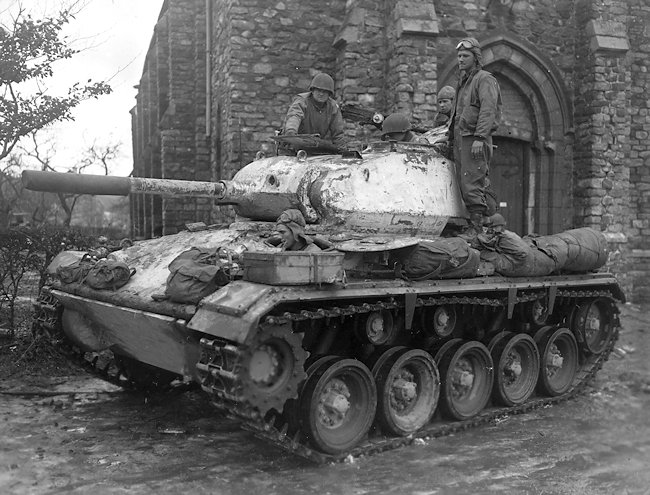
M24 Chaffee light tanks were first used in the Battle of the Bulge in the snowy Ardennes forests in December 1944. This tank belongs to the 18th Cavalry Reconnaissance Squadron, February 1945.
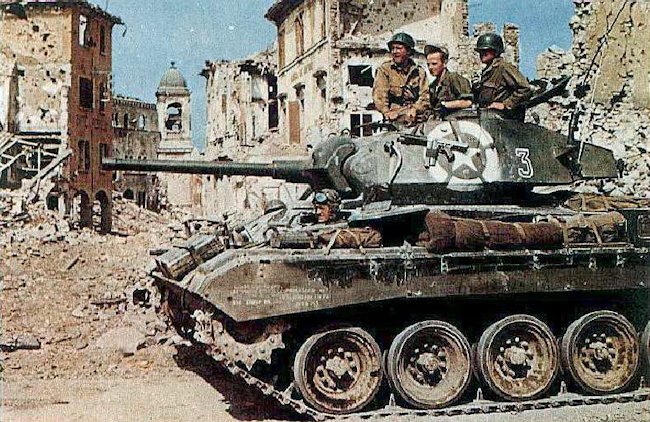
M24 Chaffee light tank of the US Army 1st Armored Division in Bologna, Italy, late April 1945
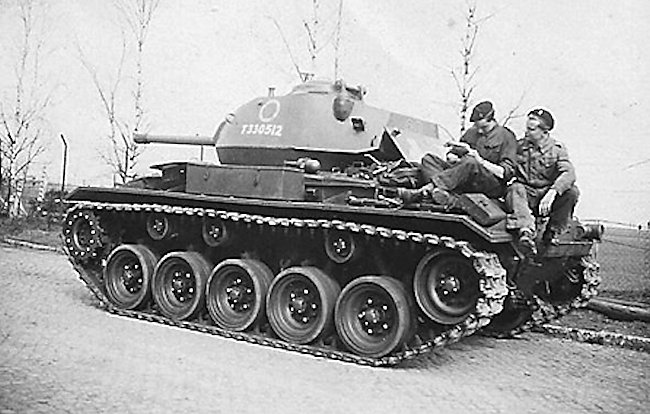
British M24 Chaffee, Light Tank C Squadron, Reconnaissance Regiment, 5th Infantry Division, Germany 1946
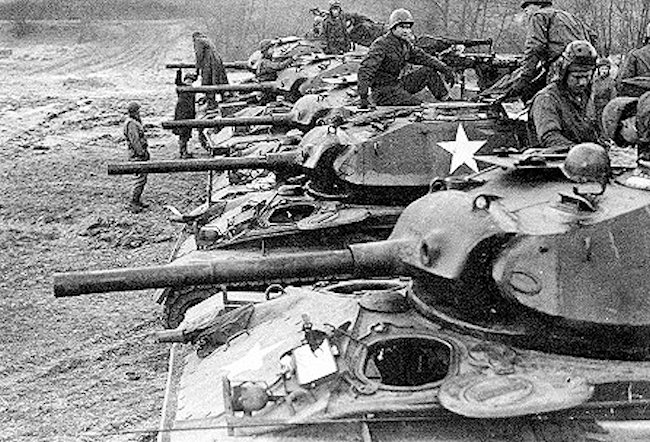
M24 Chaffee light tanks were used in the Korean War by the US Army
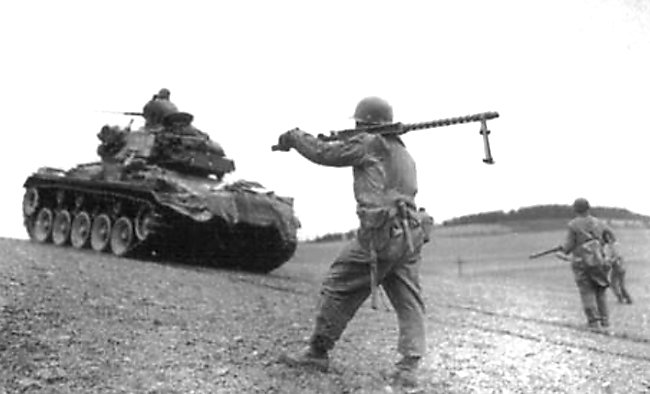
M24 Chaffee Light Tank of the 1st Infantry Division advances towards Scharfenberg, Germany, 2nd April 1945
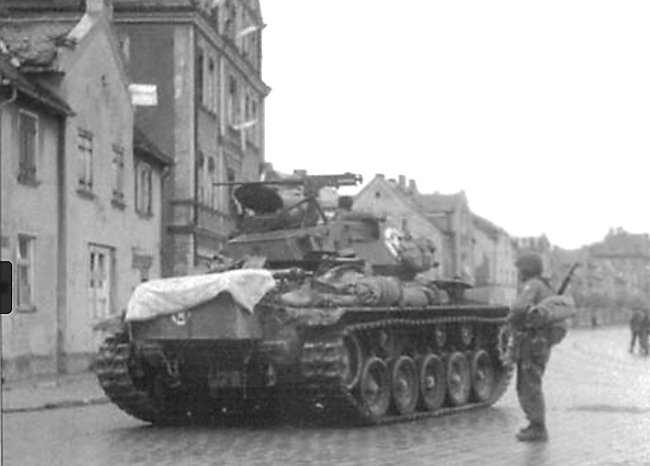
M24 sits at a cross road in Augsberg while supporting the US 3rd Infantry Division. The city surrendered 27th April 1945.
Surviving Tanks
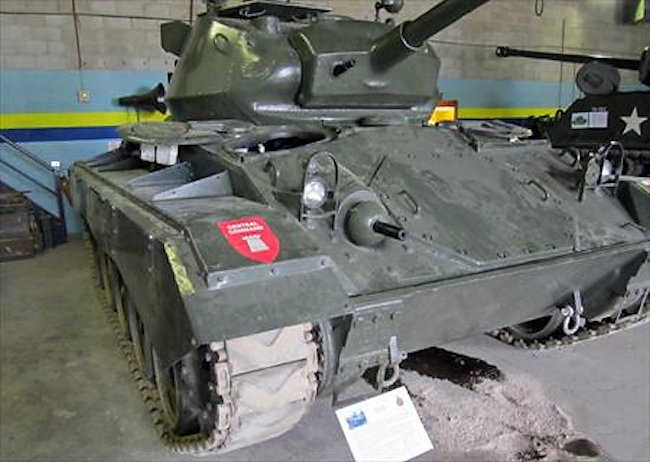
Ontario Regiment RCAC Museum M24 Chaffee Light Tank
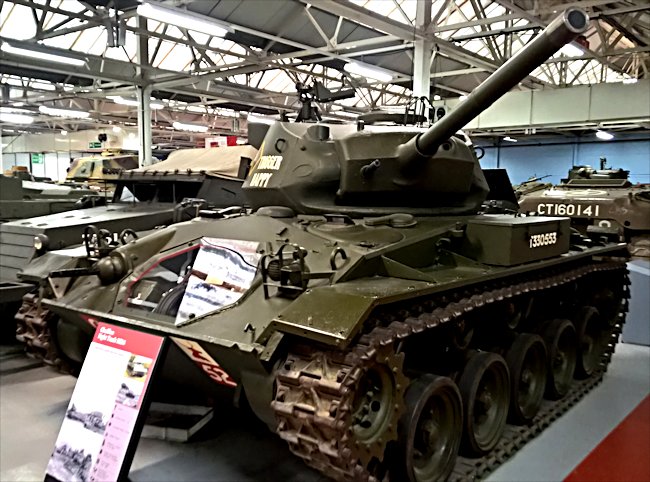
Preserved M24 Chaffee Light Tank at the Tank Museum, Bovington, Dorset in Southern England
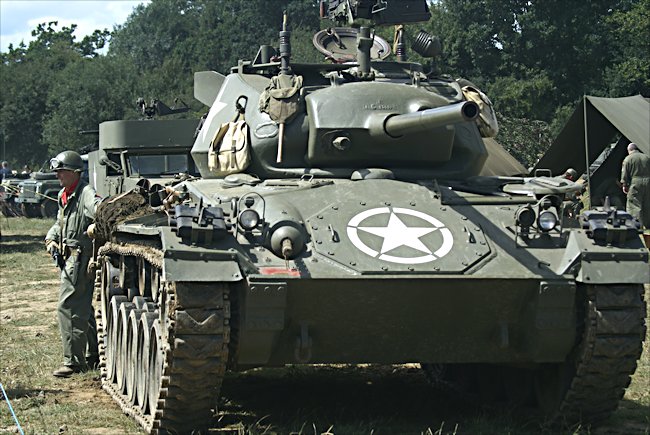
Surviving fully restored M24 Chaffee Light Tank in private ownership in England.
British Army Service M24 Chaffee in Norfolk
M24 in retrospect
Although no light tank can seriously hope to win the tank versus tank battle against a heavier opponent, the Chaffee was undoubtedly a highly successful design, simple, reliable rugged and with satisfactory hitting power for a tank of its size and weight. The way in which it has gone on in service all over the world (nineteen countries still have it in their armies even today) is a glowing tribute to its designers.
Sources
US 740th Tank Battalion history by Lt-Col. George K Rubel
United States Tanks of World War II by George Forty
US Light Tanks in Action by Steve Zaloga
US Tank Battles Germany 1944-45 – Concord Armor at War
Henk Sto on warandtactics.com
M24 Chaffee on Wikipedia
M24 Chaffee on Tank-Hunter.com

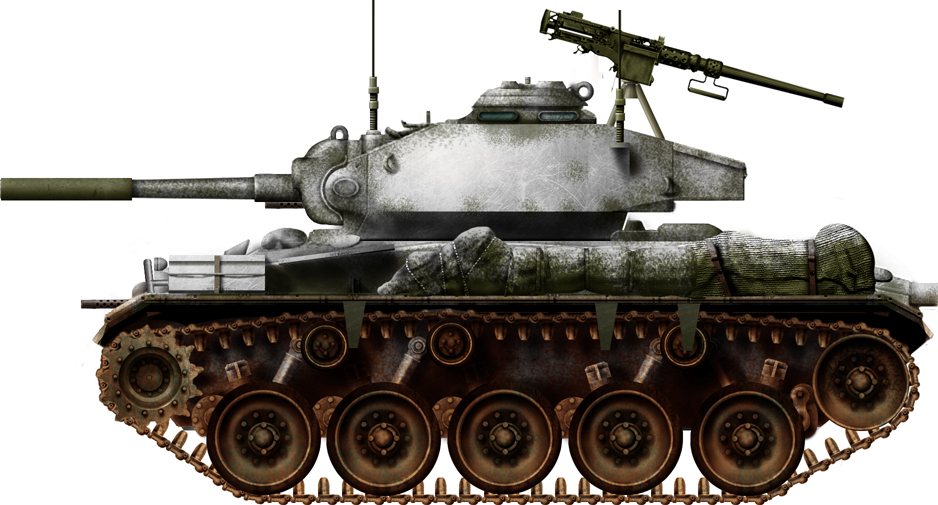
20 replies on “Light Tank M24 Chaffee”
One of the most interesting developments of the M-24 was that of the Chilean Army. They replaced the 75mm M5 with a 60mm Hyper Velicity Medium Support (HVMS) gun of Isreali design. It purpotedly could pierce the front hull of a T-54/55 tank, no small feat for its small caliber. This gun was also adapted to Chilean Army Super Shermans M-50, replacing the french 75mm gun with which they were equipped in service with the IDF. The HVMS gun had the ability of being equipped with a revolver type semi-automatic loader that allowed three shots in three seconds, although it is disputed if these autoloaders fit inside the cramped M-24 turret; these may have been equipped with a simple breech. The HVMS’s inmense muzzle velocity allowed very precise firing, with an extremely tense trajectory, which in turn allowed simpler sights for the gunner.
Thanks Juan for this very interesting insight !
Will this be added into the article? It seems like somthing worthy of adding. A “Tech” article on this 60mm Hyper Velocity Medium Support (HVMS) gun would be very interesting.
It may very well come in the future. We have an article on Sherman’s equipped with this weapon coming soon.
– TE Moderator
That sounds great, thank you.
The Belgian Army also uses some 130 M24 Chaffee from 1951-52 mainly in armoured reconnaissance units. Replaced by M41 from 1958 onwards, they were passed to reserve units.
Thanks for these infos !
Great information and a nicely done site! The color plates are really great, but I would like to offer a correction regarding one of them.
The color plate of the M24 “Claire” (752nd Tank Battalion Winter 1944-45) was inspired by a vet’s personal photo that appears on my 752nd website. Claire was allocated to the 752nd in the mid to late summer of 1945 during the postwar period, and the photo shown on my website was taken in early February 1946.
In the above color plate, the artist depicts a very unusual steel-gray coloring of the track skirt and road wheels, but in fact this particular vehicle was painted a standard OD over the entire vehicle. The photo of Claire on my website is one of a series of personal photos that were taken on the same day, and provided by the family of one of its crew members. In the photo which served as the model for the color plate, the harsh sunlight had reflected directly into the camera and blew out the tone and detail in the original image, causing certain areas of the tank to appear extremely light in color. However, the same series of photos shows Claire from different angles, without the harsh sun glare. In more normal light, the track skirts and road wheels show more detail and appear considerably darker, and more consistent in tone with the rest of the vehicle. Same day, same tank, same photographer, same camera, just different light.
While I don’t have those other photos posted on my site, my web page does include a second photo of Claire that shows the standard OD scheme very clearly. Claire’s tactical number was “D2.” A second, more distant photo of Claire “D2” can be seen at the bottom of my following web page:
http://www.752tank.com/LightTanks.html
Claire was a unique M24 in the 752nd’s postwar inventory. I have photos of the majority of the individual 752nd M24s, and Claire stands out on a few levels. So far, Claire is the only 752nd M24 I have ever seen outfitted with track skirts. It is also the only 752nd postwar M24 that I have seen that breaks the naming convention where tank names began with the “D” company letter. Finally, it is the only 752nd M24 that I’ve seen to date with a second name painted on the main gun.
Hope this helps clarify the seemingly unusual color scheme.
Bob Holt
Webmaster & Historian
752nd Tank Battalion
Hello Bob.
We have changed the description of the illustration to February 1946.
However, could you send us some of those images so that we may verify your claim?
Use our email address, [email protected], or contact us on Facebook (https://www.facebook.com/tanksencyclopedia/)
Hello,
so I just finished reading the New Vanguard published Chaffee book written by Zaloga (very nicely done, and a steal used for $2 at a library sale), and there was mention of Uruguay having equipped some of theirs with a 90mm Cockerill (now CMI Defence) gun.
Does anyone know which model of the 90mm it was, and does anyone have any pictures? This would make for a fascinating scale model to “kitbash” together.
Thank you.
We do have some pictures somewhere. If I can find them ill post the link.
– TE Moderator
Chaffee’s height is obviously incorrect in the specification table. It can’t be 1.6m high.
you are correct, it should read 2.61m, it has been fixed
TE Moderator
When I served in the 3rd Reconnaissance Squadron of the 7th Cavalry, 3rd Infantry Division in 1967-68 we had an M-24 Chaffee on display on a concrete slab with the 7th Cavalry crest painted on the front on our post, Ledward Barracks, Schweinfurt, Germany. It was called the “Garry Owen Tank.” The M-24 ran and was driven in parades. It was in the maintenance building for service one day and I got the opportunity to climb into the turret. I admired those twin Cadillac engines. It was a fine tank even in that time of the M-60 Patton MBT.
I am curious about the Spanish Chaffees. I saw a great painting in the article but no info on them. Which model were they? Were these the ones used in the awfully inaccurate but entertaining Battle of the Bulge movie? Thanks for the great article!
Hi William,
Maybe in the future we will have an article on the Spanish Chaffees.
31 arrived in Spain in 1953 and were deployed to Spanish North Africa in 1957 during the Ifni War.
However, the Spanish crews didn’t like them too much.
And yes, they were used in that and other films.
Gareth (TE Editor and Writer)
In what way was this tank “successful”? It was a cramped, thinly armored coffin for it’s crew by the time of the war. Even 3,7-cm guns could easily penetrate it.
It was fast and it was never really meant for tank-on-tank warfare. mainly just infantry support.
This is a great website. We are producing a documentary film on the 213 armored field artillery battalion during the Korean War (https://www.facebook.com/KapyongMiracle213th) that was heavily involved in the Chinese Fifth Offensive (Spring Offensive) April 1951 and the second phase of the Fifth Offensive in May 1951.
I wasn’t familiar with the artillery in one of the photos taken by a member of the 213th–then I saw your image of the “Gorilla” M41 HMC 155mm–that’s the piece. The 213th never received these, rather they entered the war with M7 Priests and then switched to towed 155mm artillery in the later part of 1951. As you noted the M41 showed up late in the war and in small number.
Just so you know, the writer accidentally said “that” twice in a row in the intro. Other than that, good job!